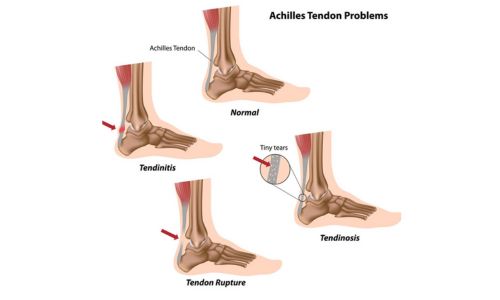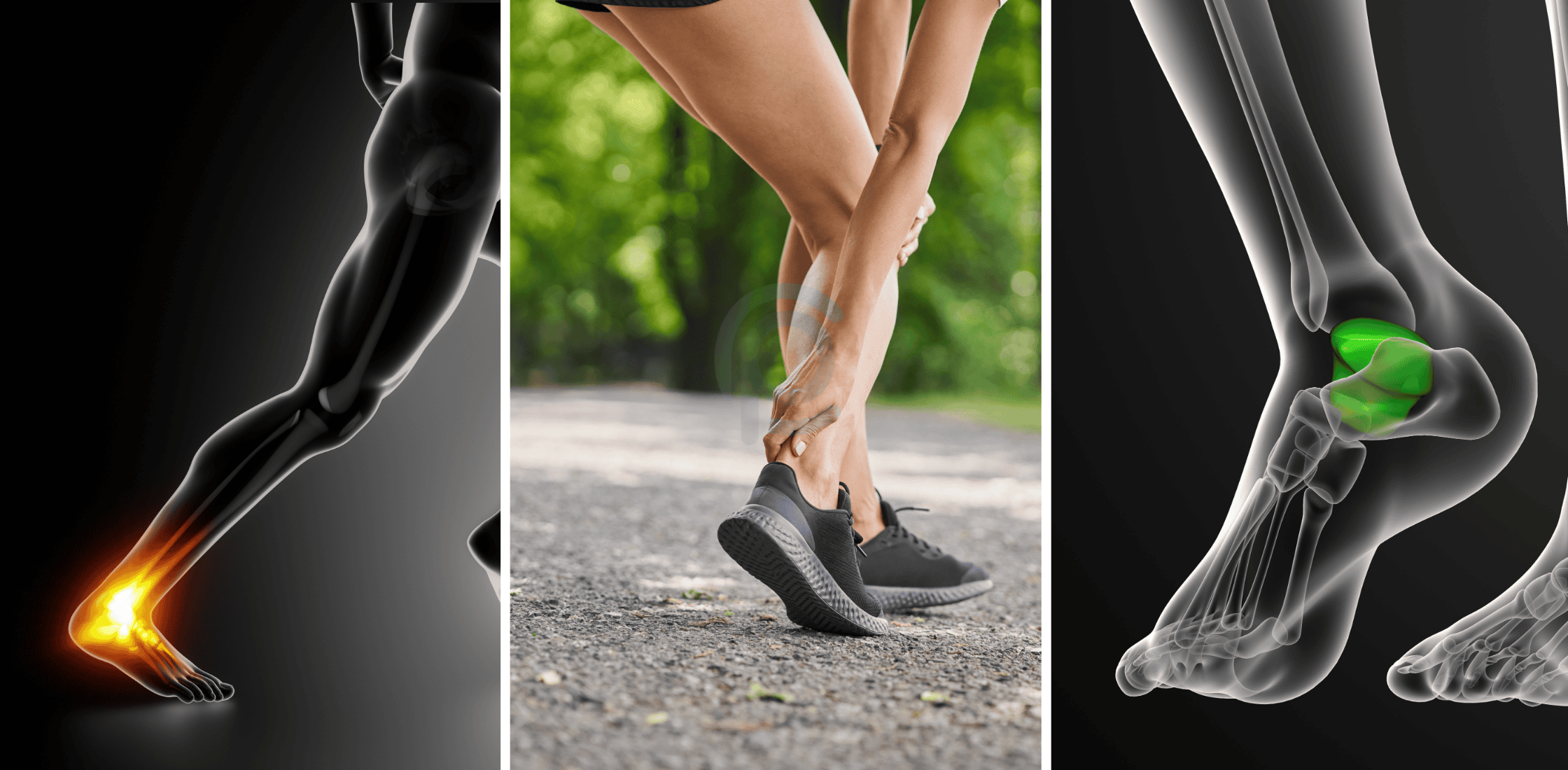What is the Achilles Tendon?
The Achilles tendon is a strong, fibrous band of tissue that connects the calf muscles to the heel bone. It is one of the longest & strongest tendons in the human body, stretching from the back of the heel to the calf. The Achilles tendon plays a vital role in enabling movement, as the contraction of the calf muscles tightens the tendon and pulls the heel. This action is essential for walking, running, and jumping, as it allows the foot, heel, and toes to move effectively.
Types of Achilles Tendon Problems
Achilles tendon issues, also known as tendinopathies, can be broadly categorized into several types, each with distinct characteristics but primarily it presents as weakness due to tiny tears in tendons or sudden rupture / tear in the tendon.
- Achilles Tendon Rupture
A rupture occurs when the tendon tears, either partially or completely. A rupture can occur from overstretching or excessive force applied to the tendon. This injury is commonly seen in athletes or individuals involved in high-impact sports, but those with a history of tendinitis or underlying conditions like diabetes are also at higher risk. - Achilles Tendinosis
Tendinosis refers to the degeneration of the Achilles tendon due to chronic inflammation. The tendon’s structure is damaged, with disorganized, thickened, and scarred fibers that can appear rubbery or hardened. This often leads to stiffness, pain, and limited mobility. - Achilles Tendinitis
Tendinitis involves acute inflammation of the Achilles tendon, typically without microscopic damage to the tendon fibers. This condition is often caused by overuse, resulting in swelling, heat, and pain. - Achilles Paratenonitis
This condition is the result of acute, repetitive strain on the Achilles tendon. The sheath around the tendon becomes inflamed, causing pain and restricted movement. It responds well to pain management and appropriate rest. - Achilles Tendon Bursitis
The retrocalcaneal bursa, located just beneath the Achilles tendon, can become inflamed, often in conjunction with Achilles tendinitis or as part of chronic conditions such as plantar fasciitis, rheumatoid arthritis, or fibromyalgia
Achilles Tendon Changes Over Time

Understanding the progression of Achilles tendon conditions can help in recognizing them early and ensuring proper treatment. The following phases reflect the changes in tendon structure:
| Phase | Name | Tendon Change | Prognosis |
| I | Reactive Tendinopathy | Normal Tissue Adaptation | Excellent – minimal treatment required |
| II | Tendon Dysrepair | Diminished load rate & Cell Loss | Good – Tendinopathy rehab program |
| III | Degenerative Tendinopathy | Diminished load rate & Cell Loss | Moderate – Tendinopathy rehab program |
| IV | Tendon Tear / Rupture | Tendon Tissue Breakdown | Loss of Function – surgery required |
Types of Achilles Tendinitis
Achilles tendinitis can be categorized into two main types:
- Non-Insertional Achilles Tendinitis
This involves inflammation and swelling of the tendon without microscopic tendon damage. It typically affects the middle portion of the Achilles tendon and is more common in younger, active individuals. - Insertional Achilles Tendinitis
Insertional tendinitis occurs at the point where the Achilles tendon attaches to the heel bone. It is a common overuse injury, often seen in people aged 40-50 and can be exacerbated by other inflammatory conditions like spondyloarthropathy, gout, or certain medications.
Common Symptoms of Achilles Tendinosis
- Pain in the Achilles tendon, often felt in the lower portion near the heel or lower portion of calf.
- Stiffness or tightness in the tendon, particularly in the mornings or after periods of inactivity.
- Pain upon activity, especially during running or jumping, which may subside as the tendon “warms up” during exercise.
- Tenderness when pressure is applied to the tendon, often felt along the length of the Achilles tendon.
- Increased pain and stiffness after activity, which may worsen the following day.
- Difficulty performing certain movements, such as pushing off the ground while walking or standing on tiptoes.
- Thickening of the tendon can be visible or palpable in some cases.
Who is at Risk of Achilles Tendinosis?
Achilles tendinosis is often seen in individuals who engage in high-impact or repetitive physical activities, but there are other factors that can increase the risk of developing this condition:
- Overuse or repetitive stress from sports that involve running, jumping, or sudden direction changes (e.g., basketball, soccer).
- Tight calf muscles or a restricted range of motion in the ankle joint, which increases tension on the Achilles tendon.
- Obesity, which can place additional strain on the Achilles tendon due to increased body weight.
- Poor biomechanics, such as over-pronation or flat feet, which can alter the position and movement of the Achilles tendon during activity.
- Inadequate footwear support that lacks proper arch support or cushioning, leading to overstrain on the tendon.
Expected Healing Time for Achilles Tendinosis
The healing time for Achilles tendinosis varies depending on the severity of the condition and how well it is managed. Generally:
- Mild to Moderate Cases: Recovery may take between 6 to 12 weeks with appropriate treatment, which includes rest, physiotherapy, and specific rehabilitation exercises.
- Severe Cases: For more advanced tendinosis with significant tendon degeneration, healing may take upto a year. Surgical intervention might be considered if non-surgical treatments fail to relieve symptoms.
Early diagnosis and treatment can significantly improve the chances of a full recovery and reduce the risk of chronic pain or tendon rupture.
How Physiotherapy Helps in Achilles Tendinosis Recovery?
Physiotherapy plays a crucial role in the recovery from Achilles tendinosis, helping to reduce symptoms and promote healing through various techniques:
- Manual Therapy: Techniques such as deep tissue massage, joint mobilizations, or myofascial release help reduce tension and improve blood circulation to the affected area.
- Stretching and Eccentric Strengthening: Focused exercises for the calf muscles and Achilles tendon help restore flexibility and strength, correcting imbalances that may have contributed to the injury. This specific type of exercise, where the tendon is lengthened while under load, has been shown to improve the healing process and strengthen the Achilles tendon.
- Foot Orthotics: Custom-made insoles can help correct abnormal foot mechanics, such as over-pronation, which may place excessive strain on the Achilles tendon.
- Taping Techniques: Taping can provide additional support and reduce movement that may aggravate the tendon, helping to prevent further damage during the healing process.
What You Can Do at Home?
To help prevent Achilles tendon injuries, it’s essential to maintain good tendon health and avoid overloading the area. Incorporating the following practices can significantly reduce the risk of developing Achilles tendonitis or tendinosis:
- Perform Stretching Exercises
Regular stretching helps maintain the flexibility of the Achilles tendon and surrounding muscles, reducing the risk of strain or injury. Focus on calf stretches and Achilles tendon stretches to improve overall mobility. - Undertake Warm-Up Exercises
Always engage in proper warm-up exercises before participating in any sport or physical activity. Warming up prepares the muscles and tendons for the activity ahead, improving circulation and reducing the risk of injury. - Gradually Increase Activity Intensity
When increasing the intensity or duration of your workouts, do so gradually. Sudden increases in load can overstrain the Achilles tendon, potentially leading to injury. - Undertake Muscle Conditioning Around the Ankle
Incorporate exercises prescribed by a physiotherapist that focus on Strengthening the muscles surrounding the ankle and calf to support the Achilles tendon, ensuring it doesn’t bear too much strain. Stronger calf muscles, in particular, reduce the amount of force transferred to the tendon during physical activities. - Lifestyle and Activity Modifications: Avoid activities that place significant strain on the Achilles tendon, such as running on hard surfaces or performing high-impact exercises, especially during the initial stages of recovery.
- Ice Therapy and Elevation: Applying ice (15-20 minutes every 2-3 hours) can help reduce swelling and inflammation, while elevating the foot above heart level can assist in decreasing swelling.
- Supportive Footwear: Choose shoes that provide adequate arch support and cushioning, which can help reduce the strain on the Achilles tendon. Avoid walking barefoot on hard surfaces or wearing shoes that don’t provide sufficient support.
- Gradual Return to Activity: Once pain subsides, return to physical activities slowly, starting with low-impact exercises like swimming or cycling before transitioning to high-impact activities like running.
Assistive Devices to Support Healing
In addition to physiotherapy, certain products can provide support and help alleviate the strain on the Achilles tendon:
- Foot Orthotics: Custom-made orthotic insoles can correct abnormal foot mechanics, such as over-pronation, and reduce strain on the Achilles tendon.
- Ankle Braces or Supports: These devices help stabilize the ankle and reduce excessive movement, offering protection during recovery.
- Ice and Compression Wraps: Ice wraps or compression bandages can help control swelling and improve circulation to the injured area.
- Footwear Modifications: Supportive shoes with proper cushioning and a slight heel raise can reduce strain on the Achilles tendon.
Tendon Health and Injury Prevention
By following proper stretching routines, warming up before exercise, gradually increasing activity intensity, and focusing on muscle conditioning around the ankle, you can significantly reduce the risk of Achilles tendon injuries. Regular care, along with addressing underlying factors such as poor footwear or mechanical imbalances, can keep the Achilles tendon functioning optimally and help avoid painful conditions like tendinitis, tendinosis, or ruptures. If you experience persistent heel pain or symptoms of Achilles tendon injury, seeking professional treatment from a qualified Physiotherapist is essential to avoid further damage and ensure long-term recovery.


















